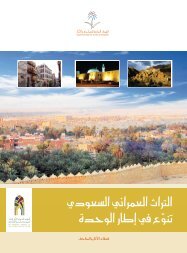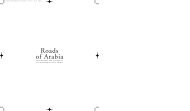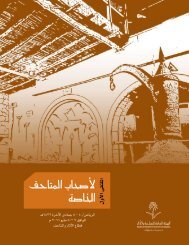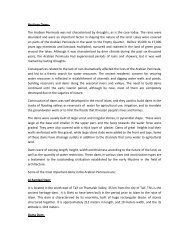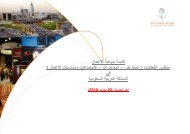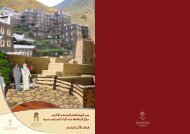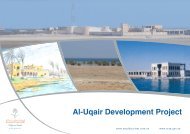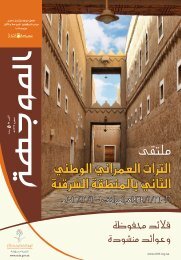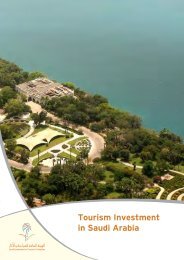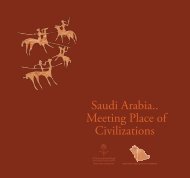ﺧïºØ¯Ù اï»ïº¤ïº®ï»£ï¯¿ï»¦
ﺧïºØ¯Ù اï»ïº¤ïº®ï»£ï¯¿ï»¦
ﺧïºØ¯Ù اï»ïº¤ïº®ï»£ï¯¿ï»¦
Create successful ePaper yourself
Turn your PDF publications into a flip-book with our unique Google optimized e-Paper software.
...rchaeology News – The Roots of Purebred Arabian Horses « Europe « Heritage Daily<br />
155<br />
/ http://www.heritagedaily.com/2011/08/the-roots-of-purebred-arabian-horses<br />
صفحة ١ من ٣<br />
٣٢/١٠/١١<br />
Search articles... Search<br />
Friday, September 9th, 2011<br />
SHOP PHOTOS VIDEO TERMS & CONDITIONS ABOUT US CONTACT US<br />
HOME FEATURED ARTICLES UNITED KINGDOM EUROPE AMERICAS AUSTRALASIA AFRICA ASIA MIDDLE EAST EVENTS<br />
You are here: Home » The Roots of Purebred Arabian Horses<br />
The Roots of Purebred Arabian Horses<br />
WRITTEN BY HERITAGE NEWS ON 29 AUGUST, 2011 - 09:36 PM - NO COMMENT YET<br />
A recent excavation in Saudi Arabia has uncovered the roots of the famous purebred Arabian Horse<br />
which are now believed to be over 20,000 years ago.<br />
The Al-Magar site is located in a very<br />
remote area of central Arabia between<br />
Tathleet and Wadi Al Dawaser at about<br />
40km from the town of Gayirah in the<br />
province of Tathleet. Al-Magar site was first<br />
discovered by a Saudi national who<br />
collected some archaeological objects<br />
scattered on the surface. Another Saudi<br />
National reported the site to the Riyadh<br />
Governorate (Amara).<br />
Riyadh Governorate referred the matter to<br />
Saudi Commission for Tourism and<br />
Antiquities which contacted the person who<br />
collected the archaeological objects. He<br />
The Al-Magar site: Image-SCTA<br />
immediately responded by returning all<br />
objects and guiding the concerned official to<br />
the site location. The Commission rewarded the two persons for their cooperation.<br />
The site area is distinguished with its special topography located at a junction point between Najid heights and the<br />
edges of the eastern mountains. The area is composed of small hills with a number of valleys scattered among<br />
them.<br />
LATEST POSTS POPULAR POSTS<br />
Archaeology project to help<br />
rehabilitate injured soldiers<br />
7 September, 2011 - 10:25 AM<br />
Who’s Your Daddy?<br />
5 September, 2011 - 09:33 AM<br />
Discovery Cast Light On Early<br />
Roman Activity In The Stroud Valley<br />
3 September, 2011 - 12:22 PM<br />
Roman Remains Found at Charles<br />
Street, Dorchester<br />
3 September, 2011 - 12:02 PM<br />
Hallaton Treasure conference -<br />
Leicester University, 5th November<br />
3 September, 2011 - 11:41 AM<br />
Tasmanian tiger’s jaw was too small<br />
to attack sheep, study shows<br />
3 September, 2011 - 11:32 AM<br />
FOLLOW US!<br />
There is a major valley across the area which once was a river running westward forming waterfalls and taking<br />
water to the low fertile lands west of Al-Magar which was situated on both banks of the river<br />
Man lived in this area before the last desertification or before the drastic climatic changes ended with the hot dry<br />
conditions and development of deserts . The early settlements in this area was largely attributed to the climatic<br />
changes. Inhabitants of this site practiced agriculture and animal breeding.<br />
On the surface there is a large scatter of archaeological objects spread in a large area and include arrow heads ,<br />
precisely-made stone scrapers similar to that used during the Neolithic period. The site is surrounded by other sites<br />
extending over a wide area where similar objects were found and typically some of them were connected with the<br />
agriculture activity.<br />
The main route linking south western Arabian<br />
Peninsula with its central area was passing<br />
near the site . This route became latter –<br />
during the past historic periods – the main<br />
trade route between Najran and al-Fao.<br />
The site represents a culture of humman<br />
groups that settled at the site long ago. We<br />
named this unique culture as AL-Magar<br />
Civilization in attribution to the name of the<br />
site.<br />
Several statues of possibly domisticated<br />
animals were found on the site which were possibly part of the daily life of the inhabitants.The animal included<br />
sheep, goats, hound dogs, ostrichs, falcons, fish and horses.<br />
The artifacts and objects found at the site showed that the Neolithic period was the last period when human being<br />
lived on the site (9000) years ago. All objects and stone tools found on the surface of the site dated back to the<br />
said history.<br />
In order to ascertain and assure the history of the site, four samples of organic burnt materials were taken from<br />
AlMagar site and sent to USA specialized Laboratory of C-14 dating. The results showed that the site dated back to<br />
9000 years ago. Near the site there are other sites more ancient than AlMagar dating back to the medium Neolithic<br />
period.<br />
TAGS<br />
Anthropology Archaeology<br />
archaeology news Art Art and<br />
design Article battlefield archaeology<br />
Blogposts Books Comment Culture Education<br />
Egypt english heritage Europe Evolution Features<br />
France G2 Greece Heritage International<br />
irish archaeology iron age israeli archaeology julie<br />
robinson London Maev Kennedy Main<br />
section Mark Brown Martin Wainwright<br />
Museums News paddy lambert religion<br />
roman Science Sculpture Steven Morris sue carter<br />
The Guardian Travel UK news<br />
vikings World news<br />
Presence of horse statues of big sizes, coupled with Neolithic artifacts and tools dating back to 9000 years ago in<br />
the site is considered an important archaeological discovery at the international arena particularly in view that the<br />
latest studies indicated that animal domestication was known for the first time 5.500 years ago in central Asia



